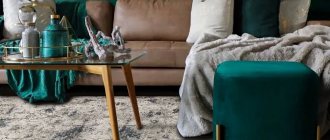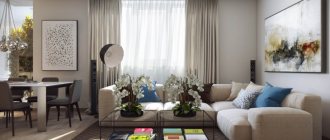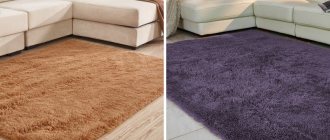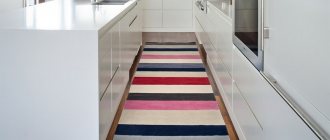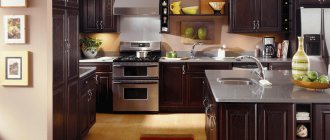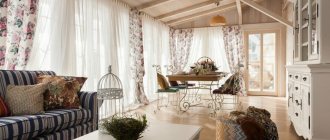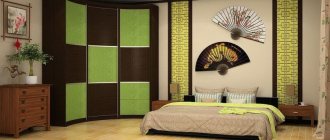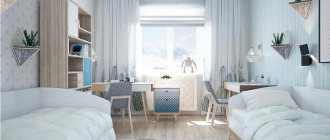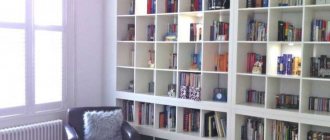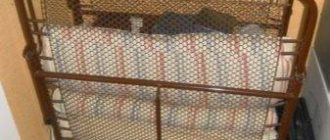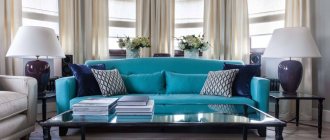Carpets have always been considered an important element of housing and an indispensable component of comfort. The number of carpet products on the market is amazing, but the more difficult it becomes to choose the very ideal model. This material will help you decide how to choose a carpet for the living room floor, tell you what characteristics of the product to pay attention to, and what to combine with it in the interior.
In the recreation area Source prom.st/
Why do you need a carpet?
It is well known that in many European interiors, carpets are not among the mandatory decorative elements. However, it is difficult to imagine a Russian home without them. Carpets are valued not only for their decorative capabilities and ability to add coziness to a room, but also for the following advantages:
- Simplify cleaning. The stain on the carpet is less noticeable than on the floor; it lingers on the material and does not scatter around the room; removing it is not difficult.
- Noise insulation. A valuable quality for those who live in panel apartment buildings.
- Thermal insulation. You cannot do without carpet products in most Russian regions. They save you from the cold in winter, which is especially important for families with children - the carpet in the nursery will prevent your child from catching a cold.
In a country house Source www.crismatec.com
- Humidity regulation. Natural carpets absorb excess moisture from the air in damp rooms, helping to normalize the microclimate.
- Benefit for health. Natural wool products with elastic pile gently massage the active points on the feet. Massage improves body tone and helps normalize blood pressure.
Woolen models have a significant disadvantage, which can cause allergies in sensitive people. However, the world's leading manufacturers have found a way to eliminate the shortcoming. Anti-allergenic products that are safe for health are used to treat wool.
Texture
By choosing the right expressive texture, you can transform the room in the right direction. Here are 3 tricks you can use when working with texture:
- Warm . Add warmth with a woven sisal or short-pile wool rug: Paired with rustic tweed upholstery and richly colored walls, these effects will warm up a room that doesn't get much sun.
- Space . To achieve a sense of spaciousness without sacrificing textural interest, consider a light, finely textured wool sisal rug in a soft gray-green or blue color scheme. Faded colors, which we associate with distance, will create a feeling of wide space even in a small room.
- Shading of areas . Pronounced texture absorbs more light than smooth surfaces. Even with the same color of yarn, high and short pile will give a completely different effect.
Size based on required coverage
Internationally, texture is the hottest topic of discussion in interior design, and nothing captivates designers more than discussing the texture a rug should have.
But what is texture? Texture is the touch sensation and behavior of a surface when it comes into contact with objects. It is not only and not so much a relief surface, such as, for example, It is not just uneven surfaces, but a textural contribution to the perception of your room - be it rough, soft, shiny, smooth or silky.
Each has its own texture and surface
The reaction to a particular material is associated with the sensation of touch. Decorated with chrome furniture, glossy walls and slate floors, the room can be described as "hard and cold". This impression would be based on the touch associated with the materials used . And warm, cozy and soft textures like wool will bring a feeling of comfort into your home.
Very soft and warm carpet
Types of materials
When deciding which carpet to choose for the living room or bedroom, most people first pay attention not only to the size or color, but also to the composition of the product. This approach is entirely justified - the material from which the coating is made directly affects its performance and quality characteristics. Based on their composition, all carpets are divided into natural, synthetic and mixed.
Emphasis on white and black Source st.hzcdn.com
Natural
The group includes carpets made from natural fibers, both industrially produced and handmade. These products have the following advantages:
- Excellent appearance. They have a soft, pleasant-to-touch pile that creates a luxurious and high-quality look.
- Diversity. You can choose a model for any room and any style.
- Practical performance characteristics. Most models are environmentally friendly, have excellent sound and heat insulation, and regulate the microclimate.
- Many natural materials are wear-resistant and designed for a very long service life while maintaining their appearance.
Natural fibers also have disadvantages. Most models are very expensive, many are subject to fading, and in areas of high use - abrasion. Products require careful care, and if not handled properly, they become a breeding ground for dust mites, the main cause of allergic reactions.
Natural fiber is abrasion resistant Source avatars.mds.yandex.net
Natural products are made from the following materials:
- Wool. Classic carpets are made from durable and warm sheep wool and serve their owners for 40-50 years. Wool carpets have a calm color scheme, since the elastic, dense fibers hardly absorb the coloring pigment (when compared with synthetic analogues), but the color practically does not fade. The disadvantage of wool is that it gets dirty quickly. If used incorrectly (high humidity), mold and moths may appear. Special impregnations help combat imperfections.
Turkish wool carpet Source arbathomes.ru
- Silk. Durable and elastic silk thread makes incredibly elegant carpets for the living room. They are significantly more expensive than their wool counterparts, but the money spent is compensated by the quality: special strength and delicate shiny pile. Thanks to the thinness of the silk threads, the carpet boasts a high density and amazing tints of color in the light. A thin thread allows for fine detailing of the design. Under constant direct sunlight, silk fades, and if washed incorrectly, it fades.
- Viscose. Although the material is of synthetic origin, it is made from cellulose fibers of natural origin, from pine and spruce wood. Viscose is pleasant to the touch and very reminiscent of silk, which is why it is often called rayon. Viscose carpets do not wrinkle, do not electrify and are wear-resistant, which makes them excellent candidates for the living room. The pattern of viscose carpets is bright, shiny, and does not fade for a long time. The main enemy of beauty is moisture, the downside of small products is that they can slip underfoot.
Viscose carpet Source kover.ru
- Cotton. Cotton thread is a cheap raw material that is often used for making handmade carpets, in pure or mixed form. Cotton products are highly hygroscopic, so it is advisable to use them in the bathroom. The disadvantages include low elasticity; lint-free models are prone to shrinkage and wrinkle easily.
- Eco-friendly materials. Durable and inexpensive carpets are made from plant materials. The fibers used are jute, hemp, bamboo, sisal (agave), coconut and seaweed. Water that gets on such a coating causes shrinkage.
Current trends Source s.yimg.com
See also: Catalog of companies that specialize in installing windows and doors
Synthetic
Compared to natural ones, synthetic carpets are more affordable and have a good price/quality ratio. They are varied in the appearance of the fibers and colors, easy to care for, but inferior to their natural counterparts in durability. Synthetic coatings are made from the following types of raw materials:
- Polyamide (nylon). Polyamide produces wear-resistant carpet products, elastic and fireproof. If you are looking for a practical carpet option for the living room floor, the modern market will often offer nylon covering. This model will delight you with the elegant shine of the fibers and immunity to microorganisms. It is easy to wash, dries quickly and does not lose its shape. Unfortunately, polyamide carpets become electrified, and in the sun they fade and become hard, even brittle.
- Polypropylene grade BCF. Rugs made from BCF yarn are decorative in appearance and unpretentious in maintenance. The fiber structure does not absorb dirt, so maintenance takes a minimum of time. The main disadvantage of budget carpets is low wear resistance. They last for a maximum of 4-5 years.
High pile Source st.hzcdn.com
- Heat-set brand polypropylene. Hit-set thread is a new synthetic material. Carpets made from Heat-set spun yarn are antistatic and have good water-repellent properties. They are more wear-resistant, do not fade in the sun, and withstand loads well. Disadvantages: tendency to crumple and melt under the influence of fire.
- Frise brand polypropylene. This yarn is made from two Heat-set threads, twisted together and processed at high temperature and humidity. Curls form on the threads, causing the yarn to become curly. The texture of the pile on carpets made from such raw materials is similar to natural wool.
- Polyester (acrylic). Acrylic fiber feels like wool and doesn't wear out much. Polyester carpets are soft and light, and, unlike wool products, do not cause allergies, although they have the same thermal conductivity as wool. They do not fade, do not deform, are easy to clean and dry quickly. The structure of the fiber is such that dirt can penetrate inside, so cleaning will be regular. Other disadvantages are electrification and the appearance of pellets on the surface over time.
Polyester carpet Source priborka.life
The best carpet manufacturers - which company to choose
A high-quality carpet from a well-known brand can serve faithfully for decades without losing its visual appeal. Some companies even provide a guarantee on their products (up to 50 years). Unfortunately, many people still continue to buy low-quality rugs and carpets of dubious origin because of their cheapness.
With this approach, you can save money only here and now, and after 3-5 years you have to take the budget rug to the garage for indefinite storage and buy another product - a more decent one.
You can purchase coverage once and for life if you choose a truly durable product from a reputable manufacturer:
- Wool&Silk;
- Longbarn Company;
- MID;
- Luzern;
- Radici Pietro.
The products of these companies deservedly take first place in our ranking of the best. And yet, it is not the manufacturer’s name that will warm your feet in winter and decorate the interior, so when buying a carpet for your apartment, you will have to take into account a number of other criteria.
Recommendations: 12 best laminate collections
12 best linoleum collections
12 Best Cork Floors
Machine and hand made carpets
Carpet products are characterized by their manufacturing method (structure). Machine-made products differ in the options for fixing fibers to the base. According to this parameter they are divided into the following types:
- Woven. The products are known for their special density; During the manufacturing process, the base and pile are formed simultaneously.
In a single color palette Source avatars.mds.yandex.net
- Needle-punched. The fabric is formed using unusual barbed needles. The fibers first intertwine themselves and then make their way into the base. The products are budget-friendly and wear-resistant.
- Needle stitching (tufting). The threads stitch the finished base. Further, the technology includes sizing the woven or non-woven base, as well as final cutting. Tufted carpets can be made with any pattern and different pile lengths.
Handmade carpets have always been considered an exclusive interior detail. The technology for their manufacture is very labor-intensive and time-consuming. The following hand weaving techniques exist:
- Hand tufting. The fiber is connected to the base using a hand-held device resembling a gun.
- Technology of two thread layers. The result is lint-free products (rugs).
- Knot weaving. Knot technology allows you to get the highest quality, beautiful and expensive models. They are made only from natural materials. Hand-woven carpets have a pattern that is identical in color on both sides.
With an unobtrusive print Source amazon.com
Selection criteria: size and shape
When deciding how to choose a carpet for the living room, they start with the basic criteria. The first step is to determine the size you need. It depends on the size of the area in the room that needs to be highlighted. If you need to allocate a relaxation area with a sofa, armchairs and a coffee table, a medium-sized model that can cover the entire area is suitable. If the rug will lie between the chairs by the fireplace, a small model will do.
By size, carpets for the living room can be divided into three groups:
- Small ones. The area of such products does not exceed three square meters. Popular varieties include models 0.6x1.1, 0.8x1.5, 1x2 and 1.5x2 m.
- Average. The area ranges from 3-6 squares. Common models are 1.5x2 and 2x3 m in size.
Round Solution Source cdn.shopify.com
- Big ones. Start from six squares. Popular dimensions are 2x3.5, 2x4, 3x4 and 3x5 m. The colors of a large carpet for the living room are selected especially carefully. If the room has a lot of bright details, choose a model with a calm pattern so as not to overload the interior.
The shape of the carpet will help make the interior more harmonious. So, a long carpet can visually lengthen a room. Oval and round shaped products are convenient to use for placing accents; Such models can become the highlight of the interior.
Rectangular and square models are ideal assistants in zoning a room. There may be several such carpets; they are selected in accordance with the size of the area that needs to be allocated. Sometimes a rug of a non-standard shape, for example, a cloud or a polygon, is chosen to decorate a living room. Such products usually harmonize with strictly defined furniture. When replacing furniture, the covering will also have to be changed.
Relaxation area by the fireplace Source amazon.com
Additional criteria: pile type and density
When thinking about how to choose a carpet, you need to pay attention to the length and structure of the pile. The following types of pile are distinguished:
- Velor (plush). Soft and smooth cut pile, the same length throughout the product; the threads are fluffed at the ends. On plain models, dirt and traces of footsteps are visible.
- Friese. Each fiber of twisted yarn resembles a small spring, so the carpet is durable; Suitable for rooms with high traffic flow. Various types of frieze models are produced with a pleasant textured appearance: looped, with a cut loop, two-textured.
- Saxony. The pile is made of thermoset twisted fiber 3-4 cm long. The product is visually indistinguishable from expensive woolen carpets, ideal for the living room.
Comfort of a long-pile carpet Source bezkovrov.com
- Berber (boucle). In bouclé products, the loops are not cut and have different lengths and densities. Thanks to their sculptural, uneven texture, they are perfect for decorating a living room or bedroom.
- Scroll. The pile loops are not cut and have different lengths. Loops of different lengths have different colors (and sometimes different fiber types). A model with a multi-level scroll pile will be a worthy budget replacement for expensive cut products.
- Shaggy. A type of Saxony pile 3-7 cm long. A shaggy long-pile carpet is warm and soft to the touch, suitable for a bedroom or zoning a favorite corner in the living room. Shaggy pile requires special care, so it is not suitable for high-traffic areas.
Density is a criterion that affects several parameters at once, including price. Most technical indicators depend on it, and, therefore, the quality and reliability of the carpet product. The first thing people pay attention to is the density of the knitting if they want to choose a good-quality carpet.
In a calm color palette Source furnituredealer.net
Density is determined by the number of knitting knots per unit area, usually per square meter, and gives the following breakdown:
- With low density. Products with an indicator of 38-100 thousand per square meter are made of coarse fiber, are unpretentious in appearance and are suitable for a cottage or hallway.
- Average density, 100-350 thousand bundles per square. Carpets are made from soft and voluminous threads, suitable for the bedroom and sitting area in the living room.
- High density, 350 thousand - 1 million. The most expensive and high-quality carpets, for example, acrylic. The downside of quality is increased weight.
- Density 1.5 million. This indicator is typical for silk. Such carpets have a sophisticated pattern and withstand harsh use, making them ideal for decorating a living room.
Combination of carpets with different textures Source i.pinimg.com
Interior style and color choice
When purchasing, a reasonable owner focuses on the purpose of the coating, and, therefore, the quality of the material and the cost. Individual criteria include size, shape and color; well chosen, they play a decisive role in the interior. The choice of color is a specific matter. Before choosing a carpet color for your living room, it is useful to become familiar with the following principles:
- The color of the carpet product should be in harmony with the furniture upholstery, curtains and other textiles.
- A light carpet in cool and calm shades visually expands the space. Products in warm, rich colors have the opposite effect.
- Large models with bright ornaments are suitable for a spacious living room with a light interior, not overloaded with pieces of furniture.
Harmony of carpet and chair Source cdn.inmyroom.ru
- In a spacious living room or studio, carpets should be in harmony with each other.
- If the floor finish is dark, choose a model of a contrasting light color to match it.
- If the living room is made in pastel colors, you can refresh it by choosing a bright floor covering. An addition in the form of decorative pillows or curtains, made in the same rich colors, will restore harmony.
It is also important to focus on the style of the living room. If it is pronounced, you should not purchase a carpet in a different style, even if it is very beautiful in itself. To choose a carpet that matches your interior, follow these recommendations:
- Traditional styles. They are suitable for products with a floral or geometric pattern characteristic of the direction. Models with ornaments consisting of a large number of decorative details are common.
- Minimalist styles. In modern interiors, they often do without carpets at all, but a monochromatic model in a discreet shade will come in handy.
In a modern interior Source www.lato.kiev.ua
- Eclecticism. The interior, which mixes several styles, allows you to experiment with flooring. In an eclectic living room you can find different carpets, but oriental models take root especially well in it.
- Modern European style. Models of different textures and shapes are suitable. The main thing is that the shades are relevant, and the carpets are in the same color scheme.
Eclecticism and traditional carpet Source www.thespruce.com
- English (Victorian) style. In good old England, with its rich colonial past, oriental rugs fit perfectly into the interior, especially if they have a vintage look.
- Scandinavian style. Natural carpets, plain or laconic natural colors would be appropriate here. In the living room, choose options with a minimum of details in the ornament. Handmade models with folk motifs will have an exclusive look.
Silk carpet in vintage style Source hottabch.net
How to lay a rug
What you need to lay a rug or carpet
The carpet is laid in almost the same way as carpet: to prevent the covering from moving, it is fixed with glue or double-sided tape. When choosing a fixation method, you need to take into account the area of the room:
- up to 12 m2 - tape is attached around the perimeter of the room;
- from 12 to 20 m2 - along the perimeter and every meter inside the contour;
- from 20 m2 – installation is carried out using carpet adhesive.
Laying methods
Step 1. Remove the old coating, clean the floor from glue residues, dirt and dust. If necessary, level the surface and eliminate other defects. Next, the surface is degreased and dried well.
Remove old covering
Clean the base from dust
Check the levelness of the floor
Remove stains of grease or other substances that may contaminate the rug
If there was glue on the floor, scrape off the residue with a putty knife.
Make sure the floor is dry
Remove skirting boards before work
Step 2. Bring the roll indoors and roll it out on the floor, avoiding creases in the product. Carefully level in corners and under walls; for convenience, you can step on and press with your foot. Level over the entire surface, eliminating creases and waves.
You can’t leave creases on the rug
Advice. If the covering consists of two or more parts, it is best to place the joints opposite the entrance - this way the carpet will be trampled less and the fibers will not fall off.
Position the joints opposite the entrance
Laying the carpet
Alignment
Step 3. To join two canvases, you need to lay one on top of the other to a width of 10 cm and carefully cut along the entire joint line with a knife, applying a metal ruler.
Scheme of laying canvases
One canvas overlaps another
You need to cut with a knife along a ruler
The joint is almost invisible
Step 4. Turn one edge of the rug towards the center of the room and attach double-sided tape to the floor. The strip of tape should be located close to the wall.
Attaching tape
Step 5. Remove the protective film and roll out the rug, pressing it tightly to the tape. Having secured the coating on one side, fasten it on the other in the same way.
Gluing the carpet to tape
Fixing with glue occurs in a similar way: the canvas is turned towards the center of the room, glue is applied, it is allowed to dry for about 20 minutes and the carpet is rolled back. Smooth the surface on top with a clean plastic spatula or simply with your hands.
Glue applied to the floor
Laying carpet with glue
Step 6. If the canvas extends onto the walls, it is cut with a mounting knife or using a special tool - a breadboard knife. It is placed against the fold of the rug and, pressing forcefully, is carried along the wall. Then they take a wooden stand, turn back the edge of the material and complete the cutting along the intended slots.
Pruning
Cutting a corner on a stand
Step 7. At the threshold, the edge of the rug must also be secured with tape. After this, screw the metal threshold so that the screws do not go through the canvas, but the threshold itself presses the cut of the carpet. The baseboards are installed last.
Edge of the palace
Threshold fixation
Installation of skirting boards
Palace in the interior of a living space
Current models for the living room
Whatever the location of the carpet in the living room, the main thing is that it fulfills its function - making the room stylish, modern and comfortable. Most living rooms are decorated in a modern style, often with a touch of classics. The following types of carpets will help harmoniously complement such interiors:
- Vintage. The muted pastel colors and distressed (faux-bleached) vintage rugs maintain a charming, nostalgic ambience. The fashion for discreet vintage is not losing ground, so models in discreet colors will take root in a variety of interiors, from minimalism and modern classics to Provence and loft.
Contrast of vintage carpet and floor Source i.pinimg.com
- Ethnic. A carpet with a suitable floral or geometric pattern will best highlight the ethnic feel of the interior. An ethnic accent can be added by choosing a product made from a material of natural origin, jute, coconut fibers or seaweed.
Ethnics in desert colors Source roomadness.com
- With a geometric or abstract pattern. Such products add expression, so they are used in most modern interior styles. They can become a color addition, an accent, or create an original effect (in the case of a 3D pattern).
With geometric pattern Source blogspot.com
- In eco style. Products in natural, natural shades, with elaborate textures are in demand not only in eco-interiors. The most natural, hand-made models of brown, olive, gray and sand shades will suit the court in many modern living rooms.
Living room in eco-style Source bezkovrov.com
Special Pattern Effects
Here are some pattern effects you may encounter:
- they compress space. Large areas of the pattern will be obscured in the room, especially if the pattern repeat is large;
- a patterned carpet masks dirt and natural wear and tear, making it popular among restaurants and hotels;
- a pattern in the form of stripes stretches the size of the room, visually lengthening the space in the direction of the stripes;
- the pattern may suggest the purpose of a particular zone. For example, the area of such a carpet may be in the dining area or meeting corner.
Stripes significantly stretch the room
Rug patterns can look really good or really bad! Some rooms suffer from pattern overdose as many rug pattern themes tend to dominate. The problem can be compounded when less obvious patterns are missed - brickwork, windows, or patterns that can be seen from the next room.
We try to avoid oversaturation with patterns
As a general rule of thumb, if the pattern is related by style or texture, the combination will likely do well, as it's safer to limit yourself to one pattern per room.
Try to model a sample rug at home before purchasing, as it may look very different in the context of your room. Make sure the pattern complements the style of the furniture .
Drawing complementary style
Briefly about the main thing
Despite new trends, carpets still remain an important part of Russian interiors, performing many functions, from decorative to protective. A carpet for a living room is selected according to several criteria, including cost, size, shape, material, as well as decorative qualities.
There are natural, synthetic and mixed models on the market; They are distinguished by a variety of appearance and performance characteristics. Mixed models combine the qualities of the other two groups, which depend on the percentage of fibers.
Machine-made and handmade carpets differ in the way the nets are secured to the base, which affects the appearance of the pile. Models with wear-resistant pile such as Saxony, Berber or Frize are suitable for the living room.
When choosing a model, you also need to decide on the size and shape. The color and pattern that matches the style of the living room will help make the carpet a harmonious part of the interior.
